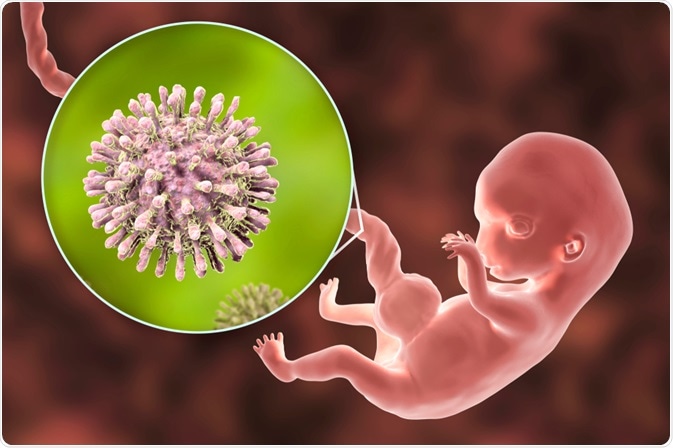Some viruses can pass generationally between mother and fetus in utero (in the case that breaks in the placental barrier are present, during delivery, or during breastfeeding). HIV, toxoplasma gondii, rubella, cytomegalovirus, and herpesviruses have been proven to transfer from mother to child via these routes. This is known as vertical transmission.
 Image Credit: Magic mine/Shutterstock.com
Image Credit: Magic mine/Shutterstock.com
The impact of vertical transmission can be devastating, with a severe impact on quality of life, and even death potential outcomes of disease transmission. There is, therefore, an urgent need to better understand vertical transmission and to develop more effective preventative strategies.
In addition, the current COVID-19 pandemic has ignited concerns over the potential capability of vertical transmission of the SARS-CoV-2 virus and what its health implications may be. Below, we discuss these key discussion points of vertical transmission.
Vertical transmission of pathogens
Babies born of pregnant women who are infected with a particular virus are at risk of contracting that virus from the parent. Transmission is more likely when the baby is in direct contact with the mother’s fluids, such as during breastfeeding and also in utero if there are breaks in the placental barrier, although most vertical transmissions occur during delivery.
Research has identified that multiple types of virus can be passed from mother to child via vertical transmission, including those known as “TORCH” pathogens: toxoplasma gondii, other (listeria monocytogenes, treponema pallidium, parvovirus, HIV, varicella zoster virus), rubella, cytomegalovirus (CMV), and herpesviruses (HSV) 1 and 2.
These viruses are a major cause of death worldwide, and while much is known about the serious health implications they pose to the newborn, the exact mechanisms of transmission through the placental barrier are not clear and infections of TORCH viruses continue.
Recently, the Zika virus (ZIKV) was identified as being transmissible vertically, adding to the TORCH pathogens which have now become a focus of research once again. The emergence of the Zika virus has reignited the need to address vertical transmission.
Even in developed countries, such as the US, infections with TORCH pathogens are linked with severe disease in infants. Additionally, infection rates in developed countries remain high, with up to 4,000 infants born in the US annually with toxoplasmosis infections which can cause blindness, developmental delay, epilepsy and more. Infections of the CMV virus are even more common, with 40,000 infants born in the US each year with congenital infections of the virus which can require complex surgical attention.
The data demonstrate the urgent need for further research to reveal the pathways the allow a virus to be vertically transmitted and leverage this into new, effective preventative approaches.
Prevention methods for vertical transmission
While more research into the mechanism of vertical transmission is needed, there are currently a number of preventative methods employed to reduce the vertical transmission of pathogens.
To prevent the vertical transmission of HIV, doctors test mothers for infection with the virus and in the case of maternal infection, the best practice involves controlling maternal infection, implementing prenatal antiviral therapy and treating the mother and baby during labor and delivery, delivering the baby by cesarean section rather than a natural birth, and avoiding breastfeeding when possible.
Further research into pathways of vertical transmission will help develop more effective protocols for HIV and other TORCH pathogens.
 Image Credit: Kateryna Kon/Shutterstock.com
Image Credit: Kateryna Kon/Shutterstock.com
Vertical transmission of COVID-19
Back in March 2020, the World Health Organization determined the COVID-19 outbreak to be a
pandemic. To date, there have been more than 113 million cases confirmed in the laboratory and more than 2.5 million deaths have been attributed to COVID-19. While COVID-19 remains a significant threat to public health, its impact on infants born to infected mothers remains unclear.
Other viral infections, such as influenza, are well documented as increasing the risk of severe illness in pregnant women. Current research seems to suggest the risk of severe disease is not typically increased in pregnant women, with minimal risk to mother and child in most cases. However, age and pre-existing conditions can increase the risk of complications (for more information on this see COVID-19 and pregnancy).
Furthermore, whilst COVID-19 in newborns is rare, there have been cases of positive COVID-19 testing within 24 hours of birth (most of which have had mild or no symptoms). It is unknown whether newborns in these cases have contracted the virus before, during or post-birth.
This has led scientists to question whether SARS-CoV-2 could be transmitted vertically. While this was never documented in SARS-CoV and Middle East respiratory syndrome (MERS), far fewer people contracted these viruses so datasets may not have been large enough to detect it.
A recent paper, published in the journal Nature Communications in October 2020, has provided data that shows that babies born to SARS-CoV-2-positive women demonstrate elevated SARS-CoV-2-specific immunoglobulin G (IgG) and IgM antibody levels. This evidence suggests transference of the virus across the placenta, and, therefore, suggests vertical transmission occurred.
Additionally, a newer study, published in the American Journal of Obstetrics and Gynecology in January this year has revealed evidence that suggests that vertical transmission is most likely when the mother is infected during the third trimester. Again, further evidence is required to more thoroughly understand the nature of vertical transmission in COVID-19.
Overall, the future prevention of vertical transmission of a range of viruses will heavily depend on the research that is conducted going forward. There is a clear need to protect children from vertical transmission in order to protect their health. The emergence of COVID-19 may help to direct attention towards this need, just as the Zika virus did.
References
- Arora, N., Sadovsky, Y., Dermody, T. and Coyne, C., 2017. Microbial Vertical Transmission during Human Pregnancy. Cell Host & Microbe, 21(5), pp.561-567. https://www.ncbi.nlm.nih.gov/pmc/articles/PMC6148370/
- Facchetti, F., Bugatti, M., Drera, E., Tripodo, C., Sartori, E., Cancila, V., Papaccio, M., Castellani, R., Casola, S., Boniotti, M., Cavadini, P. and Lavazza, A., 2020. SARS-CoV2 vertical transmission with adverse effects on the newborn revealed through integrated immunohistochemical, electron microscopy and molecular analyses of Placenta. EBioMedicine, 59, p.102951. https://www.thelancet.com/journals/ebiom/article/PIIS2352-3964(20)30327-3/fulltext
- Fenizia, C., Biasin, M., Cetin, I., Vergani, P., Mileto, D., Spinillo, A., Gismondo, M., Perotti, F., Callegari, C., Mancon, A., Cammarata, S., Beretta, I., Nebuloni, M., Trabattoni, D., Clerici, M. and Savasi, V., 2020. Analysis of SARS-CoV-2 vertical transmission during pregnancy. Nature Communications, 11(1). https://www.nature.com/articles/s41467-020-18933-4
- Kotlyar, A., Grechukhina, O., Chen, A., Popkhadze, S., Grimshaw, A., Tal, O., Taylor, H. and Tal, R., 2021. Vertical transmission of coronavirus disease 2019: a systematic review and meta-analysis. American Journal of Obstetrics and Gynecology, 224(1), pp.35-53.e3. https://www.ncbi.nlm.nih.gov/pmc/articles/PMC7392880/
Further Reading